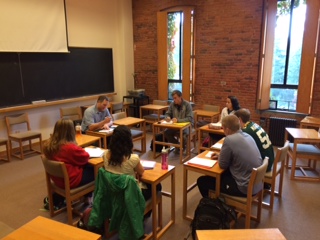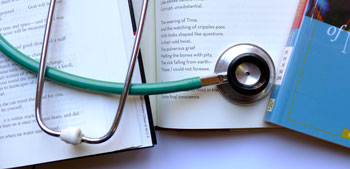Creative writing and medicine combined
New class helps bridge gap between medicine and language
October 9, 2014
By Annie Dittberner '17

CSB and SJU English instructor Chris Bolin and his students look at the connections between the practice of medicine and the arts of poetry and fiction.
English and science are two subjects that share few things in common. Incorporating the two topics into one course doesn't seem to make sense.
However, College of Saint Benedict and Saint John's University English instructor Chris Bolin says otherwise.
During the summer of 2012, Bolin used a Rooney research grant to construct the framework for a course in the medical humanities.
That fall, Bolin and CSB alumna Hannah Christensen '14 started a pilot program to prove that integrating creative writing and medicine was possible. After positive feedback and an overall successful student experience, Bolin applied to the curriculum committee to formally create Creative Writing: Clinical Encounters.
Bolin describes the course as an opportunity for pre-health science students to immerse themselves in the medical humanities.
"This course helps future clinicians learn to communicate with imagery and metaphors, while revealing connections between the practice of medicine and the arts of poetry and fiction," he said. "It allows students to see patients as people who are not defined by their diseases."
Bolin's personal connection to the medical field helped spark his interest in designing the class.
"My wife is a physician's assistant," he said. "While I noticed a lot of similarities in her medical training and the workshop model, I also noticed a lot of differences. I found a lot of problems transpiring in the communication and language of the profession."
CSB sophomore Alyssa Bossuyt enrolled in the class with the hopes of being an oncologist.
"My grandpa has cancer," the biology major said. "When he was diagnosed, his doctor explained the cancer to him in medical language and he didn't understand. And that's what this class has taught us — how to bridge the gap between medicine and language to explain it in terms where the patient understands."
Bolin decided that a writing workshop could potentially help solve this issue. "If physicians thought more about the metaphors they were using when talking to their patients, more productive conversations would result," he said.
Students improve communication skills
The year-long class meets twice a week and consists of six students.
SJU sophomore Kevin Curwick believes this class will help students master the lost art of medicine.
"I've learned that there are some things I can't understand when it comes to medicine," he said. "You may be able to understand the physiological and biological complications of a disease, but you might not be able to understand how that patient feels. This class allows us to do both."
Together, Bolin and his students analyze poems, where they depict and observe the shortcomings of the English language.
"We are given a set of poems that somehow relate to the medical field," Curwick said. "We write about things like despair and medical discovery. Some of them are physician written about their experience, others are written by patients or family members about grieving."
 Recently, the class learned the difference between someone who is experiencing pain and someone who is witnessing pain. Through poetry, the class explores the difference between the two.
Recently, the class learned the difference between someone who is experiencing pain and someone who is witnessing pain. Through poetry, the class explores the difference between the two.
"This method teaches students to empathize more with patients and teach language skills to help them communicate," Bolin said.
Through the use of poems, metaphors and figurative language, the English course helps aspiring physicians better communicate with patients.
"Rather than hearing a diagnosis and forgetting it five minutes later, the use of metaphors in a physician-patient conversation might help bridge the medical and emotional gap," Bolin added.
A local clinical experience
The creative-writing course also offers a clinical experience where students compose creative writing pieces with patients once a week.
Throughout the year, half of the students will pair with the Coborn Cancer Center in St. Cloud. The other half will travel to St. Cloud's CentraCare Dialysis Center.
Bolin describes the students' relationship with chronically ill patients as a joint exploration. "We want both of them to look through the lens of different health topics and how these things are represented in poetry and in fiction," he said.
CSB/SJU has an advantage
Because medical professional schools are beginning to incorporate medical humanity courses in their curriculum, Bolin believes that CSB and SJU students will be better prepared for graduate courses after enrolling in his class.
"The course will help undergraduate students develop their imaginative lives while they have the time and freedom to do so," he said. "It will help them make those concrete connections between their medical practice and creative lives."
According to Curwick, the class has helped him reestablish the humanities into the art that is medicine.
"Before we are given the tools to diagnose and to treat, this class provides us with the opportunity to learn to converse with a patient and try to understand their emotions," he said. "I've learned to understand the physician-patient barrier in medicine and how it needs to be breached."
Bolin hopes his students will continue to develop their imaginative lives into their future medical practices. "I want them to feel confident and comfortable incorporating their writing into their future medical lives," he added.
Similar to many other pre-health science students, Bossuyt and Curwick are often restricted to hard science classes like biology and chemistry.
"Before this class, I had never done anything with poetry in my entire life," Bossuyt said. "Now, I get to use part of my brain that I normally don't often use. I've been able to step out of the box and think in a creative way."
Curwick agrees.
"I think it would be almost irresponsible for anyone going into medicine to look past this course," Curwick said. "More and more often, medical professionals look for future physicians that have the ability to communicate better. This class is just one of the steps to achieving that."
